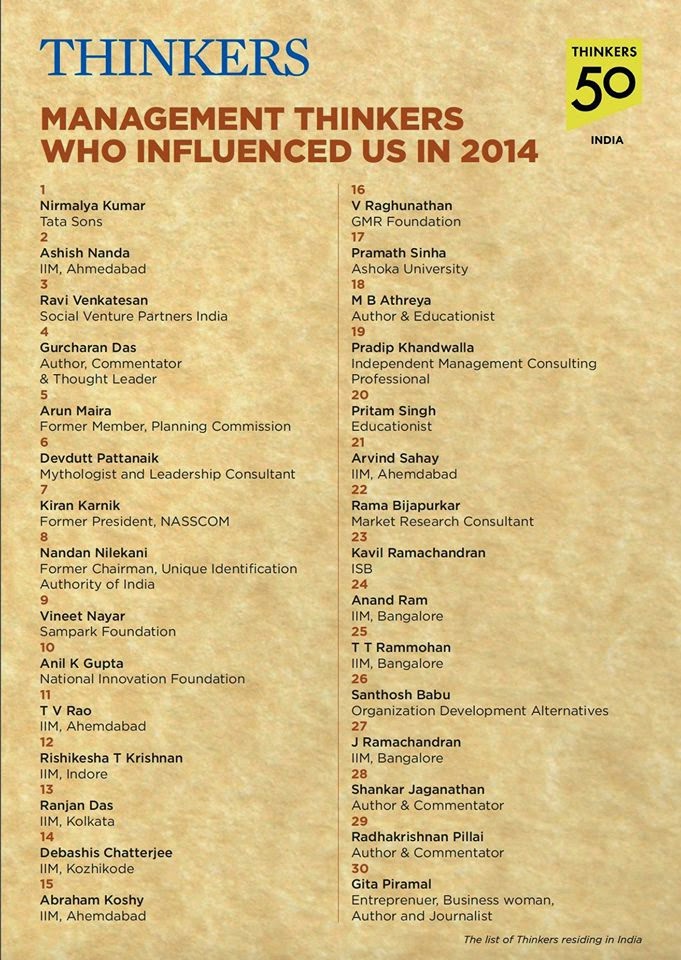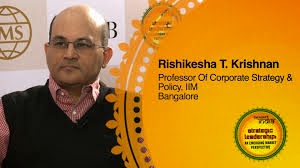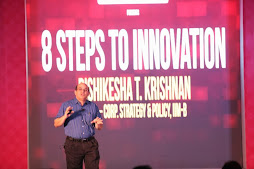One of my friends, Dr. Ardhendu Pathak, posed me an
interesting question recently: how do we create structures and platforms that
can make collaborative innovation easier, and more successful? Having
interacted with individuals and institutions across the globe he was puzzled that
as individuals we are not inferior to any other country, yet our innovation outcomes
are often not on par!
This question resonated with me because it’s closely related
to the question I posed in From Jugaad to Systematic Innovation: Why is it that
though we have talented individuals, our country does not do well on
innovation?
The Structure of Indian Industrial Innovation
Some historic context is helpful here. Post-independence, we
imitated the Russian system of creating stand-alone R&D laboratories in
different disciplines and application areas. Government directed funding
towards these institutions which became part of large R&D systems such as
the CSIR, DRDO, ICAR, ICMR, etc.
These laboratories became rather disconnected
islands of effort to build process and product technologies for use by
industry. Technology transfer and commercialization remained a perennial
problem – industry found the technologies developed incomplete and difficult to
scale; and the laboratories felt industry was not supportive of their efforts.
Universities remained outside the arena of innovation for industry.
Until the early 1990s, government funding for innovation was
directed towards these national laboratories. In contrast, R&D by firms
received little attention - the only government support for firm R&D was
tax breaks, and some relaxations on import restrictions for firms whose R&D
facilities were certified by the government.
After 1991, the government slowly changed its policies and
tried to find ways of supporting industrial innovation in firms. But the first
two programmes in this direction – HGT and PATSER – were both primarily
directed towards helping firms absorb and scale-up technologies that had been
created by the government R&D system.
The first recognition of the independent potential of firm
R&D came with the creation of the Technology Development Board (TDB) around
1996. The TDB provided low-cost loans to firms to help them commercialise
technologies without any insistence on the involvement of a government
laboratory.
None of these programmes – HGT, PATSER and TDB – had a
strategic focus. Instead they were all reactive, responding to applications received
from firms or laboratories.
Vertically integrated programmes like the Space and Atomic
Energy programmes had a different approach where they sought to do everything within
their internal networks. They went outside only when they didn’t have the
internal capabilities and even that was largely for execution – e.g. the atomic
energy programme working with a large contractor like L&T.
Perhaps the first attempt at a large scale collaborative
innovation programme was the Light Combat Aircraft (LCA) programme launched in
the mid-1980s. While a separate agency (ADA) was set up to spearhead the
development of the LCA, it was quickly realized that expertise in areas like
avionics and composites simply didn’t exist within the government system and
hence there was no option but to involve academic institutions like the IITs.
But involvement with private industry was very limited.
Why Platforms are Needed
Today, it is widely accepted that no organization has all
the knowledge it needs to innovate and compete successfully. Partnerships and
open innovation initiatives are the order of the day. Companies create their
own platforms – e.g. Procter & Gamble’s Connect & Develop – to reduce
the friction involved and systematically reach out to a wide variety of
potential partners.
At the national level, countries have realized that bringing
together key players across academia and industry can help build
competitiveness. Of course, such initiatives usually stop at the level of
pre-competitive or generic technology development. Even the United States,
historically a big votary of open competition in technology development,
experimented with initiatives like the Sematech consortium.
The First National Collaborative Platform - NMITLI
The first large scale effort to bring all the relevant
players – private industry, academic institutions and research laboratories
together – and with a view to creating some distinctive strategic position for
the country was the New Millennum India Technology Leadership Initiative
(NMITLI) launched by Dr. Mashelkar under the umbrella of CSIR in 2000.
NMITLI was distinctive because it explicitly recognized that
such collaboration may help India build a sustainable edge in some new
technology areas. However, even NMITLI retained some of the traditional
government funding structures – e.g. in a project, while the government/CSIR is
willing to make an outright grant to a university or research institution, any
funding to a company is again through a low interest loan. NMITLI has another
distinctive feature – a project can be initiated either from a corporate proposal
or through identification based on expert inputs or national consultation.
What has been the outcome of NMITLI? According to the NMITLI
website, in the first 8 years (I was unable to find more recent data –will try
to update) NMITLI supported 57 projects involving 80 industry partners, and 270
R&D groups. Outcomes included 100 international patents, and 150 papers in
high impact journals. Prominent products include Biosuite (with TCS) and
Drishtee, a 3D computational biology platform (with Strand Life Sciences). Some
drugs and medical products are undergoing trials. Its not clear whether any
project has been able to help India realize the dream of leadership in a
particular industry or domain. But its clear that NMITLI has succeeded in
bringing myriad academic and research institutions, and companies to the same
table.
CAR: A Focused Innovation Platform
Perhaps the most focused innovation platform created was the
Collaborative Automotive Research Programme (CAR) created by the office of the
Principal Scientific Adviser to the Cabinet in 2003.
In January 2011, when I met Sajid Mubashir, the officer who
coordinated the CAR programme, he explained that it came about in fortuitous
circumstances. Dr R Chidambaram, Principal Scientific Adviser to GoI, played
tennis with Capt Mohan Ram (TVS Motors) regularly. At a SIAM meeting, Mohan Ram
and other automotive heads (curiously, most of them ex- GM R&D) – V
Sumantran (then Tata Motors), Arvind Bharadwaj (Ashok Leyland) and Pawan Goenka
(Mahindra) were musing about what was needed to take the automotive industry to
the next level.
Dr. Chidambaram believed that funding the automotive sector
would have good results because being a growing industry, there was a greater
likelihood of technology getting commercialized. As a result, Dr. Chidambaram
got interested in this (by virtue of being PSA) and tasked Sajid from TIFAC
with finding out what they needed.
Six panels were formed, resulting in a 2005 Road Map
covering 30 areas. These six panels had about 12 people each (that became the
nucleus for a future network). During one year they met three times, culminating
in a meeting at IIT Madras where the topics were narrowed down. The consensus
was that the government should support the industry and bring in academia and
research institutions to undertake pre-competitive research through a
consortium approach.
As in other cases, TIFAC decided to make all government
contributions through the institutions, and as grants. Finally four areas were
narrowed down. The common demand driver for technology underlying these themes
was fuel-saving. Various dimensions of fuel-saving were identified – size
(smaller cars); light-weighting (could give upto 20% reduction in fuel
consumption) with a focus on new materials and processes in steel and
aluminium, not magnesium; engine improvement; electronics; fleet management;
alternate fuels (including electric drive vehicles and hybrids but not hydrogen
or fuel cells that were seen as too far out).
Under CAR, about Rs. 35 crores was spent on 10 consortium
projects. About one fourth to one third of the project budget went to the lead
institution; the lead institution was the conduit for the funding of other
dimensions of the project. The lead institution could commission work (e.g.
prototypes, machinery, etc. at the companies) and pay for this.
Three out of the ten projects have seen commercial outcomes.
But there is a widespread consensus that the CAR platform helped industry and
academia understand each other better, and this will provide a basis for future
collaborative work.
So, we have at least two examples of collaborative
platforms, both of which have achieved some positive results.
The Future of Collaborative Innovation Platforms in India
In recent years, there have been new efforts to create
innovation platforms. Perhaps the most ambitious is the Department of
Biotechnology’s BIRAP. The Unique ID project, Aadhaar, has provided
opportunities for a host of new applications to ride on top of it, thus
creating a platform of a different type.
In the US, one finds a number of industry-sponsored
consortia, often centered around a few key academic institutions. However,
industry associations and trade bodies in India have not taken any such initiatives
as far as I know.
India needs such platforms to help exchange information more
easily, and to smoothen out transfer of technology and commercialization. One
area crying out for such a platform is assistive devices and technologies for
the disabled. There are hundreds of projects across the country trying to build
such low-cost devices, yet few of them are commercialized or diffused. Building
a national platform to bring together and support these disjointed efforts
could help India take much better care of people with disabilities and even
aspire to be the world leader in this area.
There are several new colleges and technology institutions
across the country, keen to collaborate with industry and contribute to
technology development. The creation of some new platforms could guide and
direct these efforts to more productive outcomes, and help address the problem
that Ardhendu identified.
(The views expressed here are the personal views of the author.)




















I was one of the founder members of CAR and was involved in two programs which were completed. My point is that with knowledge and expertise distributed in different organizations, we need to create virtual teams connected electronically. The teams should be empowered to cut across organizational barriers. I am currently taking up a study on recycling with three co investigators located at IIt Kharagpur, CIPET Chennau and BARC, Mumbai. I hope we succeed in our task and set up a benchmark for such partnerships in the future
ReplyDeleteCaptain Mohan Ram